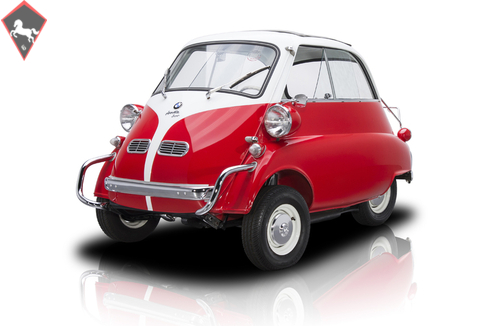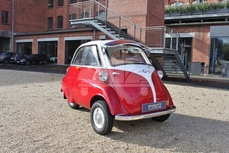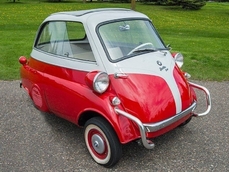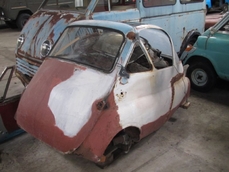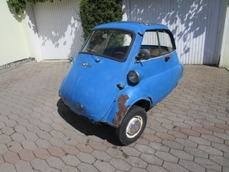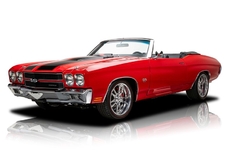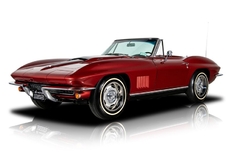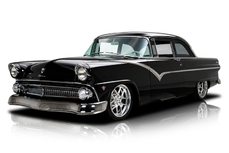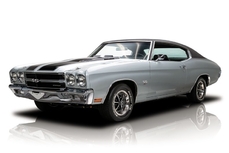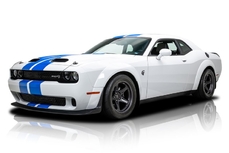BMW Isetta 298cc 1958
General description :
SUMMARY
The beneficiary of a ground-up restoration
300cc BMW 1-cylinder
4-speed manual transmission
Retractable canvas roof
10-inch steel wheels
In the collector car world, unique cars usually command big attention and serious money. That begs the question: how do you get stellar style that's wrapped around road ready mechanicals without draining your kid's college fund? Well, you can start by taking a serious look at this cool Isetta 300! A Teutonic take on Italy's beloved Iso bubble car, this classic wraps 298cc of BMW power and a row-it-yourself 4-speed in crowd-pleasing aesthetics that are the direct result of a detailed restoration. If you're in the market for a cool collectable that's guaranteed to draw a crowd, you've found your next obsession!
BODYWORK/TRIM
Fresh out of a ground-up restoration, this tidy BMW layers a fresh combination of red and white 2-stage on bulbous metal that, prior to its massage, was essentially rust-free. At the front of that pigment, a vented door hangs correct badging and a mirrored bumper between polished wipers, a polished handle and a polished horn. At the sides of that door, polished fender guards lead the eye to chrome-trimmed headlights and bullet-style marker lamps, which found sliding side windscreens beneath a canvas roof. And at the back of that roof, a small luggage rack shades a polished fuel filler, two more fender guards, a trio of taillights and a second mirrored bumper.
ENGINE/DRIVETRAIN
When the original BMW Isetta hit the scene, it featured a 250cc, 12 horsepower motorcycle engine. But, thanks to regulations adjustments, 1956 saw the introduction of the 300 model and its 298cc, 13 horsepower mill. Interestingly that micro mill spins torque to a tough 4-speed transmission. Naturally, that drivetrain rolls in a fully reconditioned chassis that's fully sorted and ready to pound the pavement. There's a quartet of drum brakes, which have no problem bringing this lightweight rig to a fast stop. And power meets the pavement through stainless-capped steelies, which twist 145/80R10 Kumho Power Star 758s in front of 145SR10 Michelin XZXs.
INTERIOR
Simplicity has always been a main selling point of the Isetta, even in the realm of classics. And you can't get much more basic than this coupe's clean cockpit. An upright bench features an appealing combination of plaid and vinyl. In front of that seat, a small mirror reflects a simple speedometer. To the left of that speedo, a pristine inner fender props a small shifter behind sparse climate control. And in front of the driver, a color-keyed steering wheel laps small foot pedals.
Vintage European metal has aged with more grace than most, wearing designs that are still capable of turning heads in their basic factory form. And since they're pretty scarce in many parts of the world, polished bubble cars get snapped up almost as quickly as they hit the market. Ready to cruise something truly unique? It's time to 'rendezvous at the Isetta'!
http://www.rkmotorscharlotte.com/sales/inventory/active/1958%20BMW%20Isetta%20300/135972
1958 BMW Isetta 298cc is listed sold on ClassicDigest in Charlotte by Donald Berard for $37500.
Car Facts
Car type : Car Make : BMW Model : Isetta Model Version : 298cc Engine size : 0.0 Model Year : 1958 Sub type : Coupé Location : Charlotte
Sold
Seller Information
Sold
People who viewed this BMW Isetta also viewed similar BMW listed at ClassicDigest
Other cars listed for sale by this dealer
About BMW
ChatGPT
Bayerische Motoren Werke, commonly known as BMW, has a rich history dating back to its founding in 1916. Initially established as an aircraft-engine manufacturer during World War I, BMW faced restrictions on aircraft production after the war. In response, the company shifted its focus to motorcycle production in 1923, marking the beginning of its involvement in the automotive industry. Subsequently, BMW entered the world of automobiles in 1928 by producing the DIXI, essentially a licensed version of the Austin 7 from the Austin Motor Company.
In the 1930s, BMW began to establish itself as a manufacturer of elegant and high-performance vehicles. One notable model from this era is the BMW 327, introduced in 1937. The 327 was available as both a coupe and a cabriolet, showcasing the brand's commitment to luxury and style. Additionally, BMW achieved success in sports car racing during this period, particularly with the BMW 328. The 328, which debuted in 1936, became renowned for its performance and aerodynamics. BMW campaigned the 328 in various racing events, including the prestigious Mille Miglia, where the company introduced several aerodynamic specials.
The post-war era proved challenging for BMW, and the company faced financial difficulties that nearly led to bankruptcy. However, BMW managed to recover and rebuild, eventually becoming one of the leading premium automotive brands globally.
As the 1960s unfolded, BMW further solidified its reputation for producing sports-oriented and luxurious vehicles. In 1968, the BMW 2002 was introduced, marking the birth of the "New Class" of compact, sporty sedans. The 2002 gained popularity for its agile handling and performance, laying the foundation for BMW's sporty image.
Moving into the 1970s, BMW expanded its lineup with the introduction of the E9 platform, which included the iconic BMW 3.0 CS coupe. The E9 series showcased BMW's commitment to blending performance and luxury. In 1972, the M1, BMW's first mid-engined sports car, made its debut. The M1 was initially developed as a racing car but later became a road-going model. The M1 laid the groundwork for BMW's high-performance M series.
In the late 1970s, the BMW E24 6 Series was introduced, offering a combination of luxury and performance. The 6 Series included models like the 630CS, 633CSi, and 635CSi, becoming a symbol of sophistication and driving pleasure.
Through these milestones and a commitment to innovation and performance, BMW has evolved into a powerhouse in the automotive industry, maintaining its status as one of the leading premium brands worldwide.
